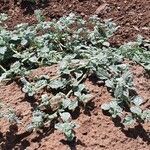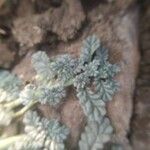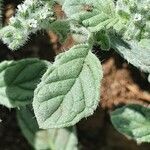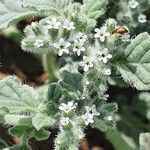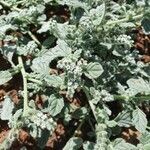Procumbent annual herb 10-50 cm wide or forming mats 0.5-1 m across; stems woody at the base, ± compressed, branched and ascending, greyish-velvety. Leaf-blades oblong, elliptic or obovate, asymmetric, 0.5-3.3 cm long, 0.3-2.2 cm wide, crenulate or lobulate, strigose between the nerves above with adpressed ± bulbous-based hairs pointing towards the apices of lobes making leaf appear plicate, with spreading hairs beneath; nerves in 4-6 pairs, impressed above; petiole 0.1-2 cm long. Flowers small, subsessile. Calyx 2.5 mm long, divided almost to the base into 4 lanceolate or ovate-lanceolate lobes, ±0.6 mm wide, often 1 lobe more developed, hairy, persistent. Corolla white, shorter than the calyx, glabrous, soon deciduous; tube ± cylindrical, 1.5-1.7 mm long, slightly narrowed at the throat; lobes 4, oblong to obovate, 0.3-0.5 mm long. Stamens 4; filaments 0.2-0.4 mm long. Ovary conical, 0.4-0.6 mm long, glandular-pubescent; styles 0.1-0.2 mm long. Fruit 3-4 mm long, glandular-hairy, apiculate, at first dividing into 2 then finally into 4 apiculate somewhat woody nutlets with rounded dorsal face with tubercles and irregular protuberances and angular ventral face. Seeds flattened-ovoid, 1.8 mm long, 1.2 mm wide.
Stems ascendingly branched, 10-50 cm long, greyish hairy. Leaves: petiole 0-5 mm long; blade 5-30 by 3-15 mm, asymmetric, oblong or obovate, crenate-dentate to lobulate, veins 4-6 on each side, impressed above, prominent beneath, strigose between veins, hairs often with bulbose base on upper, spreading on lower surface. Flowers sub-sessile. Calyx 1.5 mm long, slightly accrescent in fruit, lobes 4, lanceolate or ovate-lanceolate. Corolla white, glabrous, 1.5-1.8 mm long, tube 1-1.3 mm long, lobes ascending, 0.2-0.4 mm long, rounded. Stamens: filaments inserted above middle of corolla, included, longer than the anthers. Ovary glandular-villous; style bifid nearly to the base. Fruit 3-4 mm long, pyramidal, 4-lobed, nutlets beaked, strongly convex by vesicular, corky mesocarp dorsally, sharply angulate ventrally, with one large and one small commissural face. Fig. 3.
Herbs annual. Stems branched from base; branches prostrate or ascending, 15-40 cm, densely spreading strigose. Lower stem leaves short petiolate, oblong to obovate, 1-2 × 0.5-1.5 cm, asymmetrical, scabrous, strigose, margin coarsely crenate-lobulate; lateral veins 4-6 pairs, prominent abaxially, concave adaxially; upper leaves sessile. Flowers solitary, subsessile. Calyx 1.5-2 mm; lobes lanceolate to ovate-lanceolate, slightly enlarged in fruit, persistent, strigose. Corolla white, tubular, 2-2.5 mm, glabrous; lobes orbicular, ca. 0.3 mm. Stamens included; filaments ca. 0.3 mm, glabrous, inserted at middle of corolla tube; anthers rounded to broadly ovate, ca. 0.2 mm. Ovary fastigiate, 4-sulcate; stigma obscurely 2-cleft. Fruit broadly triangular, 3-4 mm, glandular pubescent; mericarps wrinkled, spinescent-tuberculate. Fl. Apr, fr. Jun.
Leaves with petiole 1–5(12) mm. long, on the first ones up to 40 mm. long; lamina 4–23 x 3–15 mm. (on the first leaves 25–43 x 15–32 mm.) usually oblong, sometimes circular, ovate, elliptic or obovate, plicate on the youngest leaves, with appressed hairs diverging from the nerves and converging to the teeth apex above, densely glandular-hairy below, apex rounded, base asymmetrical, cuneate on one side, obtuse to truncate on the other, margins deeply crenate to lobed.
Fruit 4–5 mm. wide, depressed-ovoid, 4-lobed, beaked and with irregular protuberances, glandular-hairy, brownish, dividing at first into 2 pairs of nutlets, later into 4 nutlets with the ventral surface angular.
Stamens inserted at c. 0.5 mm. from the base of the corolla tube; anthers c. 0.3 mm. long, suborbicular to broadly elliptic; filaments as long as the anthers, glabrous.
Ovary c. 0.4 mm. long, ovate-pyramidal, glandular-pubescent; styles slightly united at base, early concealed by the apical protuberances of the fruit.
A procumbent annual herb; stems up to 40 cm. long, radiating, angular or ± laterally compressed, much branched, densely hairy to villous.
Calyx 2.5–3.0 mm. long, a little accrescent in fruit, villous outside and inside; lobes ovate-lanceolate, subequal.
Corolla 1.5–2.2 mm. long, narrowly conical, calyptriform, early deciduous, white, glabrous.
Whitish hairy, spreading from a woody base
Small scarlet or white flowers
Flowers subsessile.
Wrinkled leaves
